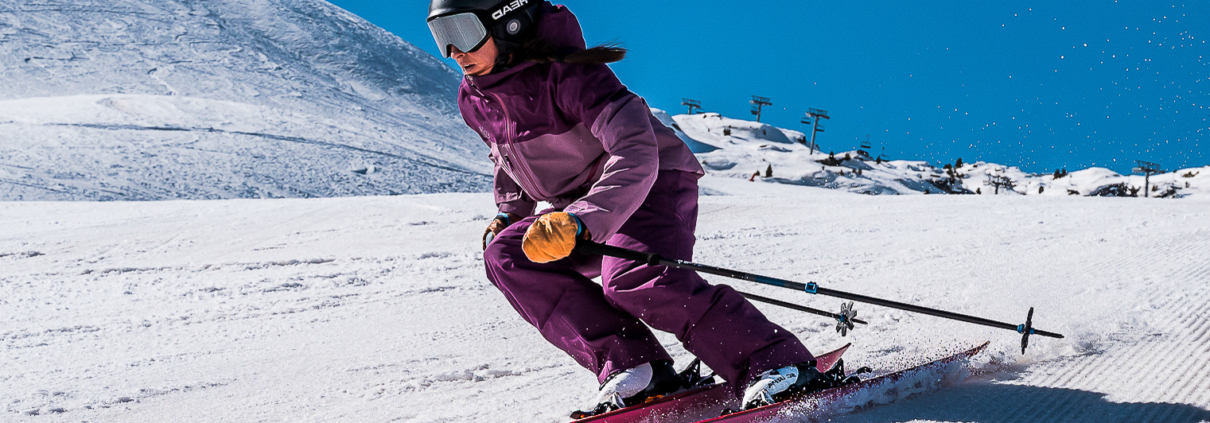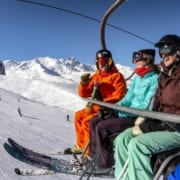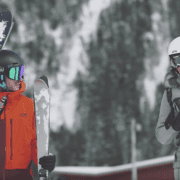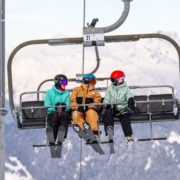Why learn to ski parallel? Because it starts to open up the whole mountain, reducing stress on your legs, as snowplough is not a very natural position. Even if you only want to cruise the greens and blues, it will make moving around the slopes easier for you and much less tiring. Not to mention how cool you’ll look!
Parallel Skiing: The Basics
- Balance early on the outside ski
- Roll both skis onto their edges to initiate the turn
- Rotate both feet and legs to steer the skis parallel
Stuck in a snow plough? Read our guide on how to take the next steps and start skiing in parallel.
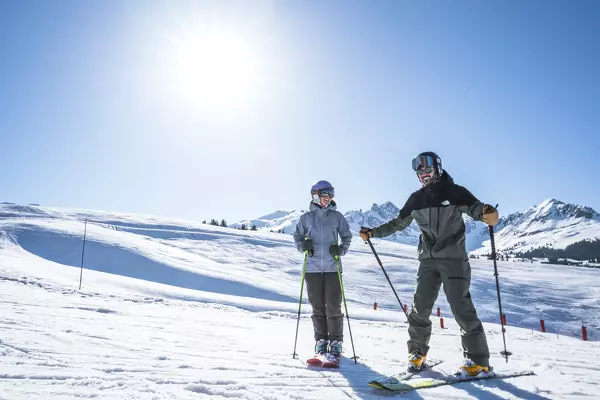
How to Make Parallel Turns
Firstly, what does it mean to ski parallel?
Skiing parallel is to control your speed and line whilst changing edges simultaneously. It’s when both skis are straight and in line with each other, mimicking the number 11.
Most skiers begin to ski in a snowplough, which creates a triangle shape with your skis (skis aren’t parallel). Often these snowploughs are referred to as pizza shape, and parallel skiing is referred to as french fries!
Parallel skiing is for those who are confident plough turners wanting to move onto blues and easy reds. So it’s time to leave those pizza’s behind!
How to ski parallel: Make your first parallel turns
Choose the slope wisely
To begin, start on a slope that you already feel confident on. If you feel assured on greens or easy blues then stay within your comfort zone and start there. Choosing the slope wisely is important because if you start on a slope too steep, you’ll find it harder to commit, which is key at this stage when making your first parallel turn.
Naturally, as you begin to start practising parallel turns, your speed will start to increase, so that’s another good reason to start somewhere where you feel confident and safe.
We’d recommend starting to make parallel turns on flatter slopes, like green or easy blue runs. With the focus on preparing for the whole mountain, specifically steeper slopes like red runs.
If you’re finding it hard to choose a ski resort for your next ski holiday, we’ve listed the Best Resorts for Beginners here. Take a look!
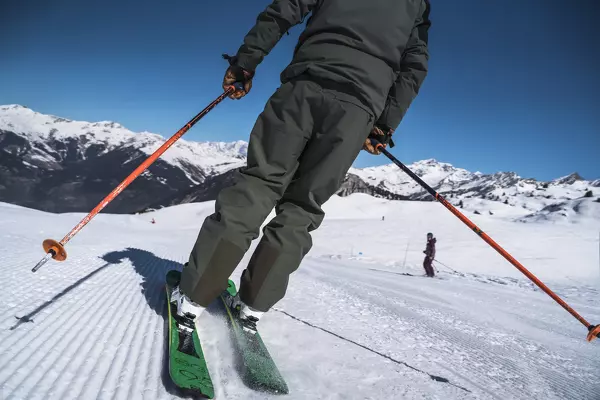
The correct technique to parallel turn
For effective parallel turning, to control your speed and line whilst changing your edges at the same time, you will need the following fundamentals in place:
- Rotation
- Edge
- Pressure Control
Increase in speed
When it comes to transitioning into parallel skiing, speed is your friend, so don’t be afraid! By decreasing the size of your plough, your speed will increase as there is less friction between the edges of your skis and the snow. Once you start to feel comfortable with a smaller snowplough, you’re halfway there to parallel skiing. Controlling speed is an important first step to skiing parallel.
Practice by keeping control of your turns
In ski lessons, we often start with a drill where we ask our customers to make their snowplough smaller when going across the slope, and larger again to turn. This is commonly known as plough parallel.
This exercise helps us stay in control when turning, but also enables us to pick up speed and momentum in between the turns when we’re travelling straight across the slope. It might feel like you’re going slowly around the turns, and then picking up a lot of speed between turns, but you will soon find your rhythm and feel in control at a constant speed.
It’s important to focus on building stability at this stage and to help stay in control, we recommend balancing on the outside ski when turning. But what does that actually mean?
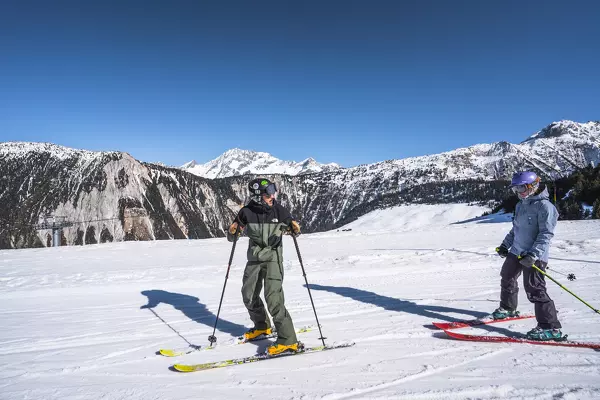
Balance on the outside ski early
By balancing on the outside ski earlier, you gain greater support earlier at the start of the turn.
But what is the outside ski?
The outside ski is the ski that is on the outside of the turn. It can sometimes be referred to as the downhill ski. So if you’re facing left, and wanting to turn to the right, your outside ski will be your left ski. And if you’re facing right, hoping to change direction to the left, your outside ski will be your right ski. Does that make sense?
If not, stand up and walk through the motion. The outside ski always makes a larger turn shape. These turns are technically called Stem Turns. Here’s a site we found useful, you might too.
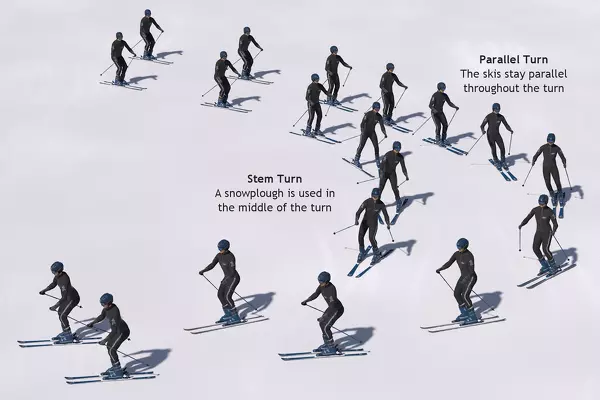
Drills for controlling your speed:
- Feel for the inside ski becoming light as you shift your body weight onto the outside ski
- Lift or tap inside ski at the end of the turn
- Keep the tip of the ski on the snow to enable a good balance
- Get used to having your skis travelling across the hill in the same direction
- Try to keep the same gap between the tips and tails at all times
If you’d like to practice these techniques with the help and feedback from a ski instructor, join our group lessons or technical clinics to improve your parallel turns.
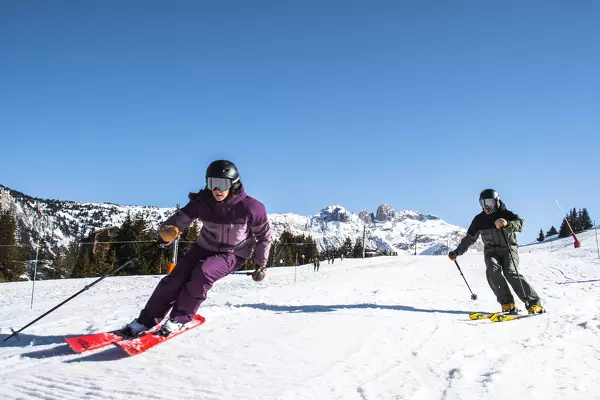
Drill for parallel skiing
- Traverse* across the slope, keeping your uphill ski very light
- Keep all your weight/balance over the lower downhill ski
- Tap or lift your uphill ski, as mentioned above
*Traversing is when you go from one side of the slope to another, without turning. As your skis glide, they are in parallel and you are only descending down the mountain slightly, so your speed shouldn’t increase much as you’re going across the slope, not down it. Please be aware of what’s going on around you on the slope before traversing straight across the slope.
Have a go at practising all of the above drills individually. Once you’ve got the hang of each one, try to link your turns together. Here are some tips to help with your parallel turns.
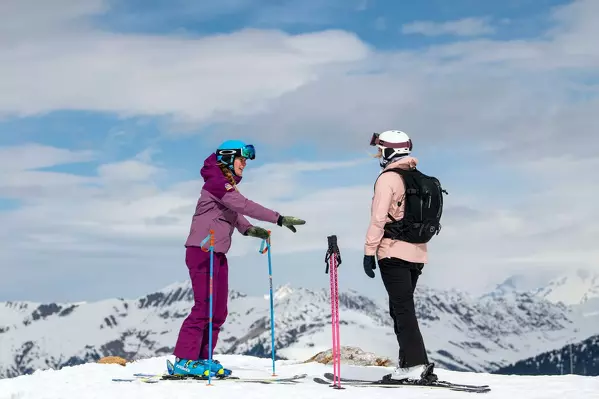
Rotate legs and feet in a smooth motion
In order to make a nice smooth turn shape, you will need to move both your legs and feet in unison to steer the skis. It’s essential to move your feet and legs at the same time in the same direction to ensure you remain in parallel.
Imagine an arc turn shape that you need to complete before your next turn. Skiing is very sensual, so if it helps to imagine driving a car around a corner smoothly: avoid any jerky movements and ride the corner before reassessing your speed ahead of the next turn.
Lengthen your outer leg
It will help to stretch your outer leg (outside ski) as you start the turn, to allow your centre of mass to move downhill and across your feet. You will find it easier to simultaneously roll your skis onto their new edges to start a new parallel turn. It’s a fantastic feeling when your skis slide and you perform your first parallel turn!
If you feel unbalanced and have weight on your uphill ski before shifting your weight onto the downhill ski, it’s likely you will lose grip and your turn will be more skidded. This makes it harder to perform a parallel turn, so make sure your upper and lower body is balanced before shifting your weight onto the downhill ski.
It might feel strange to start with, but with this new, larger range of movement from side to side, you will find it easier to commit to a new turn. Try and keep your upper body still, whilst moving your legs and feet underneath you.
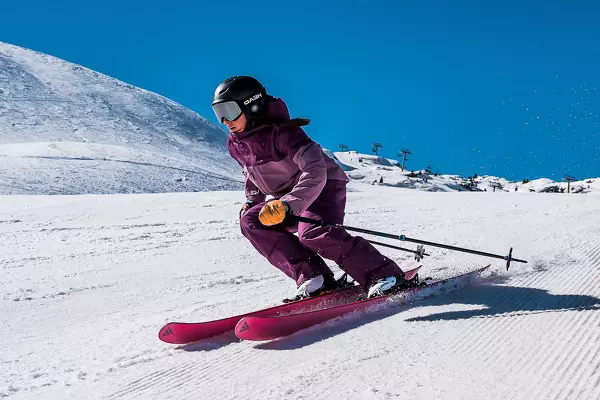
Pole Plant
As you begin to stretch your outer leg, plant your pole to help with balance and rhythm whilst turning. You will feel more coordinated and rhythmic which is essential for a flowing performance.
To make an effective pole plant, flick the pole out from your wrist, not from your shoulder. This is to ensure you don’t throw yourself off your balanced stance where your upper body is still.
Ski Tips:
When adding in the traverse with parallel skis, only do this for a few ski lengths, so you can keep a good rhythm in your turns. Rhythm is key. Sometimes it helps to count as you ski, so 1-2-3-turn-1-2-3-turn etc. It helps make consistent turns down the slope and gives you something to focus on, instead of worrying when your skis are facing down the fall line.
For safety reasons, travelling too far across the slope could cause a collision, so it’s something to be aware of. Your speed will also increase a lot if you spend too long travelling straight across the slope.
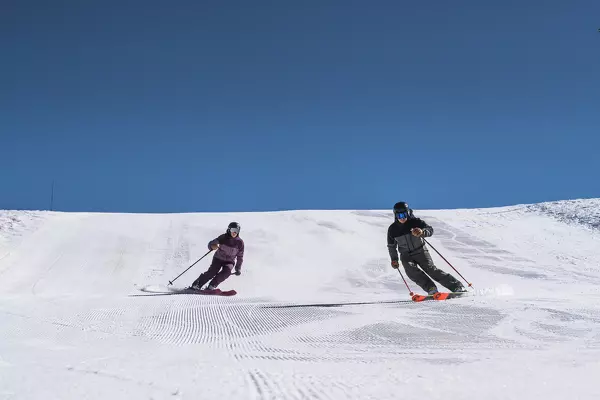
Tips to keep your skis sliding
It’s common for your inside ski to get stuck or catch on the snow. When this happens, feel for your little toe and push on it to flatten your ski. This will avoid it from getting stuck in future.
If you’re struggling with keeping your skis parallel, think about moving the tips of the skis apart rather than moving the whole ski in.
Drill
Perform a J turn (where you make the letter J on the slope), Start off in parallel, skiing down the fall line then steer both skis around a large arc to end up facing back up the hill. Use your legs to turn, rather than your body to steer the skis.
If you feel nervous skiing down the fall line, as you do pick up some speed, start off by making a small turn shape, and gradually work your way up to a large J-turn as your confidence increases.
Once you feel confident doing a J-turn, continue with the same focus as above but the key part is to have both of your skis doing the same thing throughout the turn.
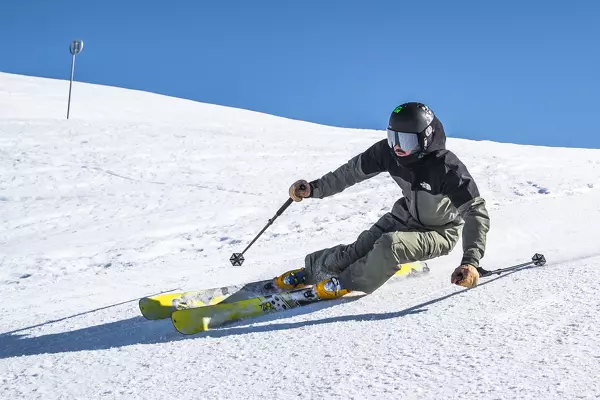
Tip
The earlier you balance against the outside ski the easier this will be. Think about riding a bike and try a pedalling action as you shift your weight onto the new downhill ski at the start of the turn. Imagine you are riding uphill, so the more effort you put in the easier it becomes.
Remember, if you have all your weight on your outside ski, your inside ski should be light and easy to move in line with your downhill ski to make a parallel turn.
Drill
To help you move your feet in unison, feel for the big toe on one foot and the little toe on the other. To really commit to the turn, roll onto the new edges of your skis, and be patient, as the skis need to flatten before they can be steered to change direction in a parallel turn.
Remember your legs are the steering wheel, not your upper body, Focus on steering with your thighs – slowly point them in the direction you want to travel in and keep your upper body position still.
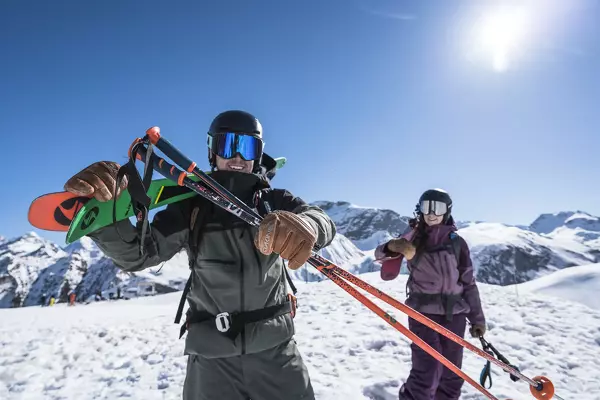
Are you confident enough to give parallel turns a go?
If you’ve enjoyed this article, and want to practice the parallel turn drills mentioned by Zoe Campbell in the mountains, join us for a group lesson or technical clinic. Or book Zoe Campbell for a private lesson in Meribel, Courchevel, St Martin de Belleville or La Tania.

